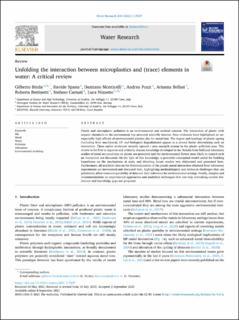| dc.contributor.author | Binda, Gilberto | |
| dc.contributor.author | Spanu, Davide | |
| dc.contributor.author | Monticelli, Damiano | |
| dc.contributor.author | Pozzi, Andrea | |
| dc.contributor.author | Bellasi, Arianna | |
| dc.contributor.author | Bettinetti, Roberta | |
| dc.contributor.author | Carnati, Stefano | |
| dc.contributor.author | Nizzetto, Luca | |
| dc.date.accessioned | 2021-10-06T09:08:00Z | |
| dc.date.available | 2021-10-06T09:08:00Z | |
| dc.date.created | 2021-09-17T08:55:52Z | |
| dc.date.issued | 2021 | |
| dc.identifier.citation | Water Research. 2021, 204, 117637. | en_US |
| dc.identifier.issn | 0043-1354 | |
| dc.identifier.uri | https://hdl.handle.net/11250/2788041 | |
| dc.description.abstract | Plastic and microplastic pollution is an environmental and societal concern. The interaction of plastic with organic chemicals in the environment has attracted scientific interest. New evidences have highlighted an unexpectedly high affinity of environmental plastics also for metal ions. The degree and typology of plastic ageing (including from mechanical, UV and biological degradations) appear as a pivotal factor determining such an interaction. These earlier evidences recently opened a new research avenue in the plastic pollution area. This review is the first to organize and critically discuss knowledge developed so far. Results from field and laboratory studies of metal accumulation on plastic are presented and the environmental factors most likely to control such an interaction are discussed. On the light of this knowledge, a generalist conceptual model useful for building hypotheses on the mechanisms at stake and directing future studies was elaborated and presented here. Furthermore, all available data on the thermodynamics of the plastic-metal interaction obtained from laboratory experiments are inventoried and discussed here, highlighting methodological and technical challenges that can potentially affect cross-comparability of data and their relevance for environmental settings. Finally, insights and recommendations on experimental approaches and analytical techniques that can help overtaking current limitations and knowledge gaps are proposed. | en_US |
| dc.language.iso | eng | en_US |
| dc.publisher | Elsevier | en_US |
| dc.rights | Navngivelse 4.0 Internasjonal | * |
| dc.rights.uri | http://creativecommons.org/licenses/by/4.0/deed.no | * |
| dc.title | Unfolding the interaction between microplastics and (trace) elements in water: A critical review | en_US |
| dc.type | Peer reviewed | en_US |
| dc.type | Journal article | en_US |
| dc.description.version | publishedVersion | en_US |
| dc.source.pagenumber | 16 | en_US |
| dc.source.volume | 204 | en_US |
| dc.source.journal | Water Research | en_US |
| dc.identifier.doi | 10.1016/j.watres.2021.117637 | |
| dc.identifier.cristin | 1935187 | |
| dc.source.articlenumber | 117637 | en_US |
| cristin.ispublished | true | |
| cristin.fulltext | original | |
| cristin.qualitycode | 2 | |

